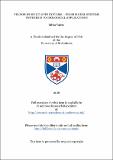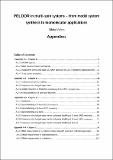Files in this item
PELDOR in multi-spin systems : from model systems synthesis to biological applications
Item metadata
| dc.contributor.advisor | Bode, Bela Ernest | |
| dc.contributor.author | Valera, Silvia | |
| dc.coverage.spatial | x, 191 p. | en_US |
| dc.date.accessioned | 2019-01-30T12:08:34Z | |
| dc.date.available | 2019-01-30T12:08:34Z | |
| dc.date.issued | 2016-11-30 | |
| dc.identifier.uri | https://hdl.handle.net/10023/16960 | |
| dc.description.abstract | Pulsed electron-electron double resonance (PELDOR) is an emerging technique for nanometre distance measurements in nano-sized assemblies and between specific sites of molecules. Most commonly nitroxide radicals are used as probes for EPR distance measurements because they are easy to introduce in biological systems such as soluble and membrane proteins or nucleic acids. PELDOR distance measurements currently rely on data processing software which has been proven to accurately extract inter-spin distances from the dipolar coupling between two paramagnetic centres. However, when the dipolar coupling is affected by contributions from other close-by unpaired electrons inaccuracies as broadening effects and artefacts are introduced in the distance distributions derived. This challenge, commonly referred as multi-spin effects, has been affecting the extraction of accurate distance information from PELDOR measurements in chemical and biological systems with multiple spin labels. The aim of this project is to approach, identify and suppress inaccuracies introduced in PELDOR-based distance distributions by multi-spin effects. This is achieved through the synthesis of multiply labelled model systems which would allow for assessment of the impact of multi-spin effects on distance measurements of simple geometries whose behaviour can be easily predicted and modelled. In this work existing methods for suppression of multi-spin effects are tested, together with their efficiency and limitations. The results are used to devise better sets of parameters including alternative settings for extraction of accurate distances from multi-spin systems and to explore their efficiency and limitations. Additional effects influencing distance measurements by pulsed EPR are also examined; in particular the effects of orientation selection and their interplay with multi-spin effects is studied in depth. Studies on rigid symmetric and asymmetric chemical model systems together with heptameric channel membrane proteins allow for outlining of recommendations for PELDOR distance measurements settings on systems presenting similar structural features, including symmetries and inter-spin distances. | en_US |
| dc.language.iso | en | en_US |
| dc.publisher | University of St Andrews | |
| dc.relation | S. Valera, K. Ackermann, C. Pliotas, H. Huang, J. H. Naismith, B. E. Bode, Accurate Extraction of Nanometer Distances in Multimers by Pulse EPR Chem. Eur. J. 2016, 22, 4700-4703. | en_US |
| dc.relation | S. Valera, B. E. Bode, Strategies for Synthesis of Yardsticks and Abaci for Nanometre Distance Measurements by Pulsed EPR Molecules 2014, 19, 20227-20256. | en_US |
| dc.relation | S. Valera, J. E. Taylor, D. S. B. Daniels, D. M. Dawson, K. S. Athukorala Arachchige, S. E. Ashbrook, A. M. Z. Slawin, B. E. Bode, A Modular Approach for the Synthesis of Nanometer-Sized Polynitroxide Multi-Spin Systems J. Org. Chem. 2014, 79, 8313–8323. | en_US |
| dc.subject.lcc | QC763.V2 | |
| dc.subject.lcsh | Electron paramagnetic resonance | en |
| dc.subject.lcsh | Spin labels | en |
| dc.title | PELDOR in multi-spin systems : from model systems synthesis to biological applications | en_US |
| dc.type | Thesis | en_US |
| dc.type.qualificationlevel | Doctoral | en_US |
| dc.type.qualificationname | PhD Doctor of Philosophy | en_US |
| dc.publisher.institution | The University of St Andrews | en_US |
This item appears in the following Collection(s)
Items in the St Andrews Research Repository are protected by copyright, with all rights reserved, unless otherwise indicated.


